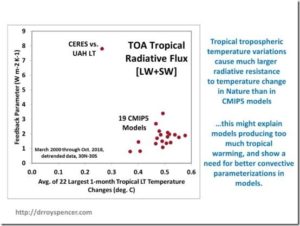by P. Homewood, 28 Sep. 2019 in NotaLotofPeopleKnowThat
Andrew Bolt is not afraid to tell the truth about our Greta. It is a pity that the media here have not got the courage to do the same…
…
16-year-old climate change activist Greta Thunberg has quickly risen to become one of the world’s most prominent political leaders, inspiring a mass movement of millions seemingly out of thin air to combat the problem of global warming.
However, the young girl’s sudden ascent to prominence is not happening by chance. She has deep connections to the globalist elite and activist parents who are supporters of the far-left domestic terrorist group ANTIFA.
Thunberg’s frequent handler is Luisa-Marie Neubauer, an operative from the ONE Movement. Neubauer can be seen behind Thunberg at many of her public events.
…
by Dr. Roy Spencer, Sep. 28, 2019 in WUWT
The radiative resistance to global temperature change is what limits the temperature change in response to radiative forcing from (say) increasing CO2, or the sun suddenly deciding to pump out a 1 percent more sunlight.
If the climate system sheds only a little extra energy with warming, it warms even more until radiative energy balance is restored. If it sheds a lot of energy, then very little warming is required to restore global energy balance. This is the climate sensitivity holy grail, and it will determine just how much warming results from increasing CO2 in the atmosphere.
John Christy and I are preparing a paper based upon Dept. of Energy-sponsored research explaining why the tropical troposphere hasn’t warmed as much in nature as in climate models. (The discrepancy exists for surface temperature trends; for both RSS and UAH tropical tropospheric trends; as well as for global reanalysis datasets). Danny Braswell and I did a lot of research on this subject about 5-10 years ago, and published several papers.
Without going into the gory details of why it is so difficult to measure “feedbacks” (how strong the climate system radiatively resists a temperature change in response to radiative forcing), I’m going to present one graph of new results from our work that suggests where the problem with the models might be.
…

…
by Alain Préat, 25 septembre 2019 in Science-Climat-Energie
Résumé : L’oxygène n’est pas apparu aussi brutalement qu’on le pensait sur notre planète (nb: première partie 1/2, ici).
Malgré un apport en oxygène lié aux cyanobactéries dès l’Archéen, ce ne se sont pas ces microorganismes qui sont à la base de la première grande ‘révolution’ de l’oxygène qui a eu lieu à la limite Archéen/Paléoprotérozoïque (il y a 2,5 milliards d’années) dans l’atmosphère, lors du Grand Evénement d’Oxydation. Ce sont les processus liés au cycle de la tectonique des plaques (activité mantellique et périodes intenses d’érosion/altération) qui ont contribué de manière déterminante à l’augmentation de la concentration de l’oxygène atmosphérique vers 2,5 milliards d’années. Les deux principaux processus responsables de cette augmentation sont liés à l’enfouissement de la matière organique et de la pyrite (= FeS2). L’altération des séries riches en ces deux composants conditionnera ensuite pendant près d’un milliard d’années la composition chimique des océans en oxygène, soufre et fer. Au cours du temps, l’oxygène proviendra de l’activité des cyanobactéries et l’atmosphère réductrice du début de l’Archéen sera remplacée par une atmosphère oxydante à la fin du Précambrien.
Abstract : Oxygen did not appear as abruptly as we thought on our planet.
Despite an oxygen supply related to cyanobacteria, since the Archean, it is not these microorganisms that are at the base of the first great oxygen revolution that took place at the Archean/Paleoproterozoic boundary (2.5 billion years) in the atmosphere during the Great Oxidation Event. Two processes related to the cycle of plate tectonics (mantle activity and intense periods of erosion/weathering) were mostly involved in the increase of the of atmospheric oxygen concentration 2.5 billion years ago. These two main processes are related to the burial of organic matter and those of pyrite(= FeS2) The alteration of series with high contents of the two elements will then condition for nearly a billion of years the oxygen, sulfur and iron chemical composition of the oceans. The oxygen will finally come from the activity of cyanobacteria and the early Archean reducing atmosphere will be replaced by an oxidizing atmosphere at the end of the Precambrian.
…
La géologie, une science plus que passionnante … et diverse

